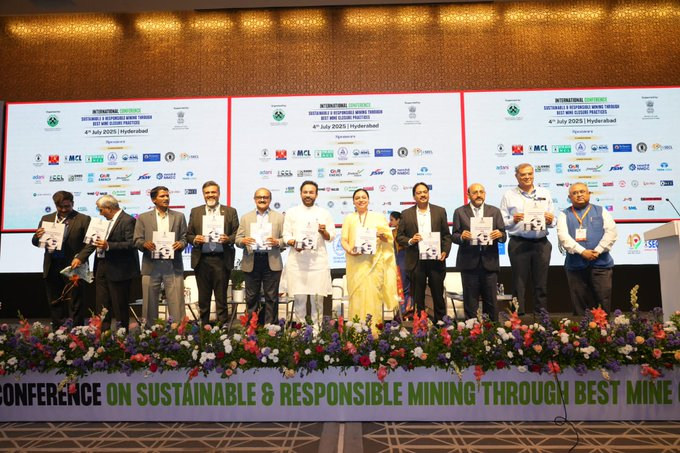G. Kishan Reddy Launches Copper Vision Document to Drive India’s Green Growth
Shri Reddy emphasized copper’s strategic importance in a future powered by renewables, electric mobility, and digitized infrastructure.

- Country:
- India
In a defining step toward securing India’s critical mineral future, Union Minister for Coal and Mines, Shri G. Kishan Reddy, unveiled the Copper Vision Document during the International Conference on Sustainable and Responsible Mining held in Hyderabad. Organized by the Indian National Committee of the World Mining Congress, the event centered on Best Mine Closure Practices—highlighting the intersection of sustainability and resource planning.
The document lays out an ambitious long-term roadmap to meet the surging domestic demand for copper, a metal crucial to India’s clean energy goals, infrastructure expansion, and modern technology industries. The launch of the vision document is aligned with Prime Minister Shri Narendra Modi’s Viksit Bharat 2047 initiative—India’s vision of becoming a fully developed, self-reliant nation by its 100th year of independence.
Copper: At the Heart of the Green and Digital Economy
Shri Reddy emphasized copper’s strategic importance in a future powered by renewables, electric mobility, and digitized infrastructure. Copper’s applications span across:
-
Electric Vehicles (EVs): from motors and batteries to charging infrastructure
-
Solar Panels and Wind Turbines: critical for energy transmission and efficiency
-
Telecommunication and Smart Cities: vital for wiring and digital infrastructure
-
Electric Grids and Storage Systems: enabling stability and efficiency in clean energy supply
“Copper is not just a metal—it is the backbone of a sustainable, electric, and connected future,” said Shri Reddy. “This vision document provides a blueprint for copper security and ensures India is prepared to lead in green technology.”
Highlights of the Copper Vision Document
The Copper Vision Document was developed through comprehensive consultations with a wide network of stakeholders, including:
-
Public and Private Sector Leaders: Hindustan Copper Ltd. (HCL), Hindalco Industries Ltd., Vedanta Ltd., Kutch Copper Ltd., Indo-Asia Copper Ltd.
-
Recycling and Clean-Tech Companies: Lohum
-
Industry Associations: Indian Primary Copper Producers Association (IPCPA), International Copper Association (ICA)
Key Focus Areas of the Vision Document Include:
-
🟢 Projected Demand Surge: Domestic copper demand is expected to increase six-fold by 2047, driven by electrification, urbanization, and decarbonization efforts.
-
🏭 Capacity Expansion: Plans to add 5 million tonnes per annum (TPA) of smelting and refining capacity by 2030, significantly increasing India’s processing capabilities.
-
♻️ Secondary Refining and Recycling: Emphasis on expanding secondary refining infrastructure to boost recycling, enabling a circular economy for copper.
-
🌍 Global Partnerships: Strategy to reduce dependence on open-market imports by securing overseas mineral assets through bilateral and multilateral cooperation.
-
🔬 Research & Development: Encouraging innovation in extraction and processing technologies, enhancing efficiency and environmental performance.
Reducing Import Dependency and Enhancing Resource Security
Currently, India imports a significant portion of its copper requirement, especially in the form of refined copper and concentrates. The Vision Document aims to bridge this gap by scaling domestic production, strengthening the recycling ecosystem, and strategically acquiring copper assets overseas.
These steps will reduce exposure to price volatility and supply chain disruptions, while supporting the Make in India and Atmanirbhar Bharat (self-reliant India) missions.
A Sustainable and Responsible Mining Future
The international conference, where the document was launched, highlighted the growing need for sustainable mining practices, especially in light of increasing global focus on environmental, social, and governance (ESG) standards. The Copper Vision Document complements these themes by embedding responsible mining, mine closure protocols, and community inclusion into India’s copper strategy.
Shri Reddy noted that copper sector growth must go hand-in-hand with ecological responsibility, reinforcing India’s leadership in green mining practices.
Moving Toward Viksit Bharat 2047
The Copper Vision Document contributes to the broader national blueprint for Viksit Bharat by addressing several cross-cutting goals:
✅ Industrial growth and job creation
✅ Technological innovation and clean energy leadership
✅ Infrastructure development in both rural and urban India
✅ Global trade competitiveness through raw material security
As India accelerates toward becoming a global economic leader, copper will serve as a critical enabler across sectors, from renewable energy and transport to defense and data centers.
A Strategic, Future-Ready Framework
With this visionary document, India has taken a firm step toward building a resilient, self-sufficient, and environmentally conscious copper ecosystem. As global demand for copper rises in tandem with net-zero goals and energy transitions, India’s timely move to secure its copper future demonstrates strategic foresight and national preparedness.
Shri G. Kishan Reddy called upon all stakeholders to collaborate in executing the roadmap, ensuring that India not only meets its future copper needs but becomes a global hub for copper innovation and production.
ALSO READ
China-EU Trade Leaders Discuss Electric Vehicles and Market Access
Paving the Path to Sustainable Mining: North East Conclave Drives Change
Luxeed: Revolutionizing Electric Vehicles with Cash Incentives
Odisha Shifts Gears: EV Policy 2.0 Targets 50% Electric Vehicles by 2036
Oil Shockwaves: Australia's Urgent Transition to Electric Vehicles










